- About
- Programs
- After School Classes
- All-School Assemblies
- The BE KIND Business
- The BE KIND Community Education Center
- The BE KIND SCHOOL
- BE KIND on the MOVE
- Classroom Resources
- #CyberSkills
- Family Engagement
- Fitness Programs
- Gardens
- Grace’s Group
- Health & Wellness
- Summer Programs
- Teacher Training
- Wellness Wednesday
- Athletes for Arizona
- Events
- Get Involved
- Donate
Walk Towards a Better You
- Home
- Wellness Wednesday
- Emotional Wellness
- Walk Towards a Better You
Walking Your Way to a Healthier, Kinder Body and Mind
How Exercise Improves Mental Health

Ways To Walk towards a Better YOU!
Let’s take a journey of health and happiness for National Walking Month. We’re exploring the incredible benefits that walking can bring to both our physical and mental well-being. Recent studies show that walking is one of the best exercises for health. Walking is a simple, yet powerful activity that has the potential to transform our lives in remarkable ways. So, why is walking good for you? And how many steps do you REALLY need? Lace up your shoes, take a deep breath, and join us as we discover how walking can pave the path to a healthier body and a kinder mind.
According to Mayo Clinic, these are some of the physical benefits of walking:
- Improved Cardiovascular Fitness: Walking regularly helps strengthen the heart, improves blood circulation, and lowers the risk of heart disease.
- Weight Management: Movement aids in burning calories and maintaining a healthy weight.
- Increased Muscle Strength and Tone: It engages various muscle groups, including the legs, buttocks, and core, leading to improved strength and tone.
- Enhanced Joint Flexibility and Mobility: Walking helps lubricate the joints, reducing stiffness and increasing flexibility.
- Improved Bone Health: Weight-bearing exercises like walking stimulate bone density, reducing the risk of osteoporosis.
- Lowered Blood Pressure: Regular walking can help lower blood pressure and maintain healthy levels.
- Boosted Immune System: Moderate exercise, like walking, strengthens the immune system, reducing the risk of illness.
- Increased Energy Levels: Exercise releases endorphins and improves oxygen flow, increasing energy and reducing fatigue.
- Better Digestion: Walking stimulates the digestive system, aiding in digestion and preventing constipation.
- Long-term Health Benefits: Walking regularly can reduce the risk of chronic conditions such as type 2 diabetes, stroke, and certain types of cancer.
The National Institute of Health lists these mental health benefits:
- Reduced Stress and Anxiety: Walking releases feel-good hormones (endorphins) and helps alleviate stress and anxiety.
- Improved Mood: Regular walking boosts mood, promotes a sense of well-being, and reduces symptoms of depression.
- Enhanced Cognitive Function: Exercise supports brain health by improving memory, concentration, and overall cognitive function.
- Increased Creativity: Walking in nature or a stimulating environment can spark creativity and enhance problem-solving abilities.
- Better Sleep Quality: A walk can help regulate sleep patterns, leading to improved sleep quality and a more rested mind.
- Stress Management: Walking serves as a natural stress management tool, providing a break from daily pressures and promoting relaxation.
- Increased Self-Esteem: Consistent walking can improve body image, self-confidence, and overall self-esteem.
- Improved Mental Clarity: Taking a walk helps clear the mind, improve focus, and enhance mental clarity.
- Social Engagement: Walking with others or joining walking groups provides opportunities for social interaction, reducing feelings of isolation.
- Overall Well-Being: Regular walking contributes to a sense of overall well-being, leading to a happier and more fulfilling life.
Finding Motivation to Walk or Exercise More
- Set Goals: Establish clear and achievable goals for your walking or exercise routine. Whether it’s a certain number of steps per day, a specific distance, or a target time, having a goal to work towards can keep you focused and motivated.
- Do I need to get 10,000 steps every day? While this is a great target, the current Physical Activity Guidelines for Americans recommends adults get 150 minutes of moderate-intensity physical activity and 2 days of muscle-strengthening activity every week. The physical benefits of walking or any exercise depend on three things: duration, intensity, and frequency. Aim to create goals based on your abilities and increase as you can.
- Track Your Progress: Use a fitness tracker or a smartphone app to monitor your walking progress. Seeing your steps, distance, and improvement over time can provide a sense of accomplishment and motivate you to keep going.
- Find a Walking Buddy: Walk with a friend, family member, or join a walking group. Having a companion can make walking more enjoyable, provide accountability, and give you someone to share your progress and challenges with.
- Mix Up Your Routes: Explore different walking routes to keep things interesting. Discover new parks, trails, or neighborhoods in your area. Changing your scenery can prevent boredom and make each walk feel fresh and exciting.
- Listen to Music or Podcasts: Create a playlist of energizing songs or listen to interesting podcasts during your walks. Music or engaging content can make your walks more enjoyable and provide a distraction from fatigue or monotony.
- Join Walking Challenges: Participate in virtual or community walking challenges. Many apps and websites offer challenges where you can compete with others or set personal milestones. The element of competition and the sense of accomplishment can boost motivation.
- Reward Yourself: Set up a reward system for achieving your walking goals. Treat yourself to something you enjoy, like a relaxing bath, a favorite snack, or a new piece of workout gear. Rewards can provide positive reinforcement and keep you motivated.
- Track Non-Scale Victories: Focus on the non-scale benefits of walking, such as improved mood, increased energy, reduced stress, or better sleep. Pay attention to how walking positively impacts your overall well-being. Celebrate these victories and use them as motivation to continue.
- Practice Mindfulness: Use your walking time as an opportunity for mindfulness. Pay attention to your surroundings and the rhythm of your steps. Engage your senses and appreciate the present moment. Mindful walking can enhance your connection with your body and the experience itself.
- Stay Positive: Be kind to yourself if you miss a day or fall short of your goals. Remember that consistency is more important than perfection. Stay positive, adapt to challenges, and focus on the long-term benefits of a regular walking routine.
Practical Tips
- Schedule it: Treat exercise as an important appointment and schedule it into your daily agenda. Block out specific time slots for walking and make it non-negotiable.
- Start small and build up: If you’re new to walking or have limited time, begin with shorter walks. Aim for 10-15 minutes and gradually increase the duration as you become more comfortable. Remember, even short walks provide benefits.
- Walking breaks: Instead of taking coffee or snack breaks, take walking breaks. Use your break time to walk around the office building, neighborhood, or nearby park. It can provide a refreshing break from work and boost productivity.
- Active commuting: If possible, walk or bike to work instead of driving or taking public transport. Alternatively, park your vehicle a bit farther away from your destination to allow for a walk.
- Walking meetings: If you have the flexibility, suggest walking meetings with colleagues or friends. Instead of sitting in a conference room or coffee shop, take your discussions outdoors and combine work or socializing with exercise.
- Step challenges: Use a fitness tracker or smartphone app that counts steps. Challenge yourself to achieve a certain step count goal each day. This can provide motivation and make walking more engaging.
- Lunchtime walks: Instead of spending your entire lunch break sitting, use part of it for a brisk walk. Pack a healthy lunch and find a nearby park or walking trail where you can enjoy your meal while getting some exercise.
- Family or pet walks: Incorporate walking into family time by going for walks with your partner, children, or pets. It’s a great way to bond, stay active, and instill healthy habits in your loved ones.
- Be flexible: If your schedule is unpredictable, find opportunities to fit in walks whenever possible. It could be during your child’s sports practice, while waiting for an appointment, or during a work break. Adapt to the circumstances and seize those moments.
Let’s walk towards better health, one step at a time. Remember, every step counts when it comes to improving both your physical and mental well-being. Lace up your shoes, embrace the world around you, and enjoy the journey ahead. Happy walking, and may it bring you endless benefits of kindness to yourself and those around you!
Published on May 31, 2023
Questions? Comments? Want to contribute to the Wellness Wednesday Blog?
Send your ideas to info@bkpp.org.

Learn More about The Be Kind People Project®
- Programs
- After School Classes
- All-School Assemblies
- The BE KIND Academy
- The BE KIND Business
- The Be Kind Break
- The BE KIND School
- The BE KIND on the MOVE
- #CyberSkills
- Family Engagement
- Fitness Programs
- Gardens
- Grace’s Group
- Health & Wellness
- Summer Programs
- Teacher Training
- Wellness Wednesday
- Athletes for Arizona
Copyright © The Be Kind People Project | Privacy Policy


